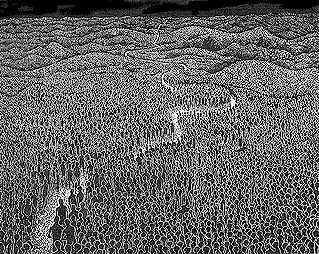Wood engraving can be a surprisingly lengthy process and I sometimes
nurture an idea for years before transferring it to a block. Probably the most difficult
part is deciding which of the ideas, teeming and agitating in my mind, are most worth
pursuing.
Off and on, over several years, I have been working on drawings of
Hadrian's Wall with its switchback hills and bleak outlook. This was an area I visited
frequently when in the North East. It had been engraved many times before but I still
wanted to do it, despite hesitating and wondering what I could contribute to such a
familiar feature.
 |
The Wall - wood engraving |
Then, as often happens, I was distracted by a different, though related,
idea and scribbled it down. My sketch had a similar snaking line through its centre, but
this time the "wall" was a gulf: the invisible barrier that prevents people from
communicating. I knew immediately that it would work as an engraving and a block was
ready. The rudimentary sketch was sufficient for me to proceed to drawing the line of the
wall-path directly on to the surface of block. This had been prepared with a thin coat of
dark grey gouache which allows me to see both the black ball-point drawing and the white
marks of the engraved image as it emerges.
Although the path itself remained fairly consistent with the original
sketch, its appearance changed significantly, during the engraving, to accommodate the
height of the people at its margins; otherwise it would have been obscured in the parts
where it changed direction. I prefer to work in this way, intuitively and directly. The
thought of, initially, drawing all those people on paper appals me; then to trace,
transfer and, for a fourth time, to draw them all over again with the spitsticker (an
engraving tool) would have killed all my interest in the project. It is risky, but
exciting, to plunge straight into a block and work the engraving out as I go. Part of the
pleasure is in not knowing what I shall eventually execute in detail in the supporting
structure; wondering who these people are as I work on their heads and profiles; and, most
of all, puzzling over why they are so prejudiced or perhaps apathetic. There is nothing to
stop them from crossing the path and talking to those on the other side; one or two are
trying but others are shouting abuse. There is tension. Many in the crowd are bewildered
or frightened. Some are not sure if this is a rally or even a celebration.
As soon as "The Wall" was finished, I knew what I had to do
with "Hadrian's Wall". In between, however, I swung from the wide-angled outlook
of a whole nation to the individual in a similar predicament and engraved "The
Neighbour's Fence". Here, the figure at the centre is erecting a precarious and
absurd barrier when, instead, it would have been so simple for him to talk to his
neighbour and resolve their difficulties.
Hilary Paynter RE
The artist can be contacted at:
19 Montague Road
Richmond
Surrey TW10 6QW
England
Tel: 0181 9403553
 The information resource for printmakers
The information resource for printmakers
 The information resource for printmakers
The information resource for printmakers